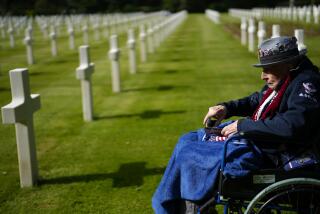‘Ike’: More substance than style
It is time again, and not for the last time, to mark the anniversary (60 this year, astonishingly) of the Normandy invasion by the Allied Expeditionary Force, which the American mind reflexively regards as the beginning of the end of the Second World War -- the Russians, at least, might differ. Television, the voice of the people -- or more properly, the voice at the people -- naturally is rife with commemorations, celebrations, sundry tales of military dedication and derring-do and reruns of “The Longest Day.”
A&E;’s entry into the fray is “Ike: Countdown to D-Day” (premiering tonight), a TV movie about Gen. Dwight D. Eisenhower in the months leading to the invasion.
Episodic in the extreme, the film is more a series of tableaux vivants than a coherent drama, but the tableaux in this case are especially vivants and, as they cover a short period of time, knit into an acceptable semblance of reality. As Eisenhower, Tom Selleck (who either shaved most of his head for the role or has been wearing a dynamite rug all these years) is not really a physical or vocal match for the supreme commander of the Allied Expeditionary Force, but he quickly makes it not matter. It’s not what you’d call a bravura performance -- the part doesn’t call for it -- but he communicates a corn-fed gravity and innate vitality and intimates the enormous weight of the decisions the general was required to make.
Ike is something of a superhero here; this is partly the fault of history, which proved his ideas right, but also because his various nemeses (Gens. Bernard Montgomery, George S. Patton, Charles de Gaulle) are rendered as cartoons by contrast. (Winston Churchill was seemingly more of a cartoon in life than he is here, played by Ian Mune, though you will find him with cigar, brandy and bowler all in order.) Eisenhower is painted as the perfection of a kind of unshowy American resolve that John Wayne and Jimmy Stewart used to represent in the moving pictures.
His charm -- it was as much his job to get men of large ego to work together as it was to oversee the details of the campaign -- is indivisible from his honesty. If he loses his temper sometimes, he always finds it again quickly. He’s humble, uninterested in personal glory -- he keeps dodging the press, not in the current weaselly sense but because, as he tells his aide, “we’re surrounded by some of the biggest swelled heads in history,” and he means to keep his own unswollen. And he feels everyone’s pain. The imminent dead are referred to ceaselessly.
Certainly one of the quietest war movies ever made -- not so much as a practice round of ammunition is fired -- it transpires essentially as a series of meetings in big, mostly empty rooms. (There is little of the crowded hustle and bustle one would expect to have attended the onset of the biggest invasion ever, but whether that is a matter of accurate history or of filmmaking economy I can’t say.)
It opens with Eisenhower and Churchill in midconversation, as Ike lights the first of the countless cigarettes he will smoke during the next two hours and demands “complete and unfettered command” over Operation Overlord. Then comes a scene between Eisenhower and Omar Bradley (James Remar), then Churchill and Montgomery (Bruce Phillips), then Eisenhower and Patton (Gerald McRaney) and so on.
The queen pays a visit too, as does De Gaulle (Charles Shevstov), who is painted in the most unflattering tones, although he and Eisenhower had an apparently cordial, respectful relationship. (Churchill hated him, though.)
Screenwriter Lionel Chetwynd has written more docudramas than you can shake a set of encyclopedias at (including “The Hanoi Hilton,” “Kissinger and Nixon” and the whimsical “DC 9/11: Time of Crisis”) and knows how to distill a stack of research into plausible, if highly aphoristic, dialogue. He doesn’t explain more than is necessary -- in fact, he wisely explains a little less, which helps create an air of realism. His overall strategy seems to be to camouflage speechifying with small talk, and the actors have no trouble selling his words.
Shot in New Zealand -- though mostly indoors -- the film affects a largely khaki tone, that slightly bleached look that’s become par for the course in military period pieces. But the visuals are anything but drab. Director Robert Harmon (“The Hitcher,” “Gotti”) and/or cinematographer David Gribble have a gift for dynamic compositions; the placement of bodies in space adds an energy to the simplest scenes.
For those wanting to know more, A&E; adds a two-hour Eisenhower “Biography,” premiering Tuesday night at 8. Even cursory research reveals a man deeper and more complex than his image and, by recent standards, a veritable poet-philosopher. “Humility must always be the portion of any man who receives acclaim earned in blood of his followers and sacrifices of his friends,” Eisenhower said at the war’s end, a thought that ought to be posted in large block letters in every office in Washington.
*
‘Ike: Countdown to D-Day’
Where: A&E;
When: 8 to 10 tonight; repeats at 10 p.m., midnight and 2 a.m. Tuesday
Rating: The network has rated the film TV-PG (may not be suitable for young viewers).
Tom Selleck...Dwight D. Eisenhower
James Remar...Omar N. Bradley
Timothy Bottoms...Walter “Beetle” Smith
Gerald McRaney...George S. Patton
Ian Mune...Winston Churchill
Bruce Phillips...Bernard Montgomery
George Shevtsov...Charles de Gaulle
Executive producers Lionel Chetwynd, Stephanie Germain. Director Robert Harmon. Writer Lionel Chetwynd.
More to Read
Only good movies
Get the Indie Focus newsletter, Mark Olsen's weekly guide to the world of cinema.
You may occasionally receive promotional content from the Los Angeles Times.











